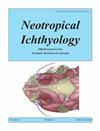巴西Chapada dos parrecis, Juruena,上部里约热内卢的翠绿四元:一种新的限定范围连枝苔藓(特征:连枝苔藓科)
IF 2
4区 生物学
Q1 ZOOLOGY
引用次数: 2
摘要
摘要:报道了巴西里约热内卢Tapajós盆地里约热内卢Juruena的一条支流里约热内卢Mutum的一新种。该新分类群与其同属分类群的区别在于:体表上有一条定义明确且相对狭窄的深色中侧条纹,从头部延伸至尾鳍中部,存在肱骨斑点,雄性尾鳍镰形远端轮廓,13-16条分叉的尾鳍(相对于17-26条),尾柄周围有11或12行水平鳞片。新物种在脂肪鳍的存在方面表现出多态性,并对这种多态性在整个家族及其系统意义进行了讨论。本文章由计算机程序翻译,如有差异,请以英文原文为准。
The emerald green tetra: a new restricted-range Hyphessobrycon (Characiformes: Characidae) from the upper rio Juruena, Chapada dos Parecis, Brazil
ABSTRACT A new species of Hyphessobrycon is described from the rio Mutum, a tributary of the rio Juruena, rio Tapajós basin, Brazil. The new taxon can be distinguished from its congeners by the presence of a well-defined and relatively narrow dark midlateral stripe on body, extending from head to the middle caudal-fin rays, presence of a humeral blotch, distal profile of the anal fin falcate in males, 13-16 branched anal-fin rays (vs. 17-26), and 11 or 12 horizontal scale rows around caudal peduncle. The new species shows polymorphism regarding the presence of the adipose fin, and a discussion on this type of polymorphism across the family and its systematic implications is presented.
求助全文
通过发布文献求助,成功后即可免费获取论文全文。
去求助
来源期刊

Neotropical Ichthyology
生物-动物学
CiteScore
2.80
自引率
17.60%
发文量
24
审稿时长
6-12 weeks
期刊介绍:
Neotropical Ichthyology is the official journal of the Sociedade Brasileira de Ictiologia (SBI). It is an international peer-reviewed Open Access periodical that publishes original articles and reviews exclusively on Neotropical freshwater and marine fishes and constitutes an International Forum to disclose and discuss results of original research on the diversity of marine, estuarine and freshwater Neotropical fishes.
-Frequency: Four issues per year published only online since 2020, using the ‘rolling pass’ system, which posts articles online immediately as soon as they are ready for publication. A searchable and citable Digital Object Identifier (DOI) is assigned to each article immediately after online publication, with no need to await the issue’s closing.
-Areas of interest: Biology, Biochemistry and Physiology, Ecology, Ethology, Genetics and Molecular Biology, Systematics.
-Peer review process: The Editor-in-Chief screens each manuscript submitted to Neotropical Ichthyology to verify whether it is within the journal’s scope and policy, presents original research and follows the journal’s guidelines. After passing through the initial screening, articles are assigned to a Section Editor, who then assigns an Associate Editor to start the single blind review process.
 求助内容:
求助内容: 应助结果提醒方式:
应助结果提醒方式:


